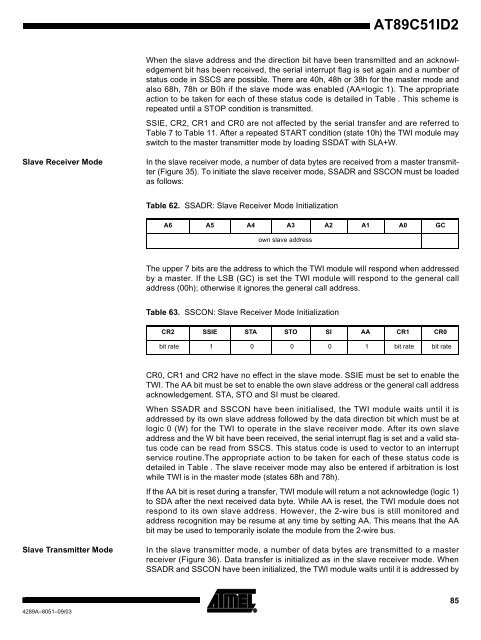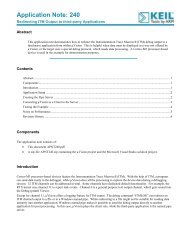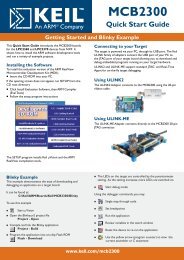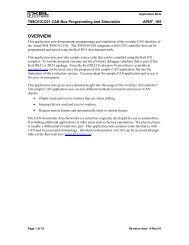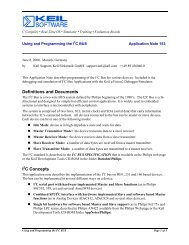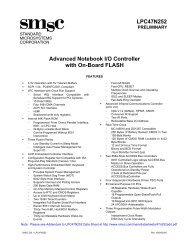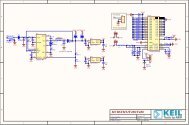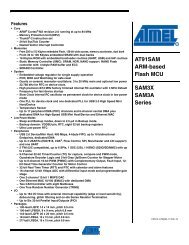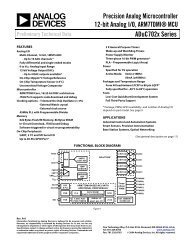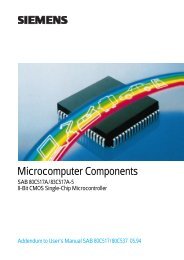Create successful ePaper yourself
Turn your PDF publications into a flip-book with our unique Google optimized e-Paper software.
4289A–8051–09/03<br />
<strong>AT89C51ID2</strong><br />
When the slave address and the direction bit have been transmitted and an acknowledgement<br />
bit has been received, the serial interrupt flag is set again and a number of<br />
status code in SSCS are possible. There are 40h, 48h or 38h for the master mode and<br />
also 68h, 78h or B0h if the slave mode was enabled (AA=logic 1). The appropriate<br />
action to be taken for each of these status code is detailed in Table . This scheme is<br />
repeated until a STOP condition is transmitted.<br />
SSIE, CR2, CR1 and CR0 are not affected by the serial transfer and are referred to<br />
Table 7 to Table 11. After a repeated START condition (state 10h) the TWI module may<br />
switch to the master transmitter mode by loading SSDAT with SLA+W.<br />
Slave Receiver Mode In the slave receiver mode, a number of data bytes are received from a master transmitter<br />
(Figure 35). To initiate the slave receiver mode, SSADR and SSCON must be loaded<br />
as follows:<br />
Table 62. SSADR: Slave Receiver Mode Initialization<br />
A6 A5 A4 A3 A2 A1 A0 GC<br />
own slave address<br />
The upper 7 bits are the address to which the TWI module will respond when addressed<br />
by a master. If the LSB (GC) is set the TWI module will respond to the general call<br />
address (00h); otherwise it ignores the general call address.<br />
Table 63. SSCON: Slave Receiver Mode Initialization<br />
CR2 SSIE STA STO SI AA CR1 CR0<br />
bit rate 1 0 0 0 1 bit rate bit rate<br />
CR0, CR1 and CR2 have no effect in the slave mode. SSIE must be set to enable the<br />
TWI. The AA bit must be set to enable the own slave address or the general call address<br />
acknowledgement. STA, STO and SI must be cleared.<br />
When SSADR and SSCON have been initialised, the TWI module waits until it is<br />
addressed by its own slave address followed by the data direction bit which must be at<br />
logic 0 (W) for the TWI to operate in the slave receiver mode. After its own slave<br />
address and the W bit have been received, the serial interrupt flag is set and a valid status<br />
code can be read from SSCS. This status code is used to vector to an interrupt<br />
service routine.The appropriate action to be taken for each of these status code is<br />
detailed in Table . The slave receiver mode may also be entered if arbitration is lost<br />
while TWI is in the master mode (states 68h and 78h).<br />
If the AA bit is reset during a transfer, TWI module will return a not acknowledge (logic 1)<br />
to SDA after the next received data byte. While AA is reset, the TWI module does not<br />
respond to its own slave address. However, the 2-wire bus is still monitored and<br />
address recognition may be resume at any time by setting AA. This means that the AA<br />
bit may be used to temporarily isolate the module from the 2-wire bus.<br />
Slave Transmitter Mode In the slave transmitter mode, a number of data bytes are transmitted to a master<br />
receiver (Figure 36). <strong>Data</strong> transfer is initialized as in the slave receiver mode. When<br />
SSADR and SSCON have been initialized, the TWI module waits until it is addressed by<br />
85


